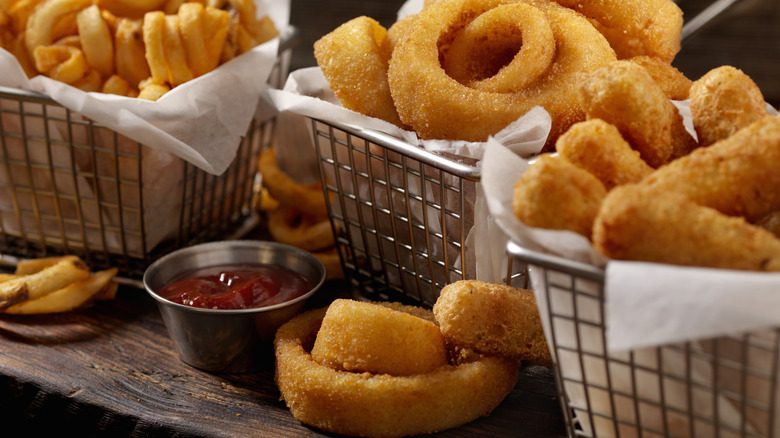The Reason You Shouldn't Oven Roast Foods That Are Meant To Be Fried
From thick-cut fries to crunchy onion rings, ooey-gooey mozzarella sticks, and crispy churros, some culinary delights were made to be fried. Keeping foods crunchy yet juicy, frying is the ultimate cooking method for some foods. However, frying isn't without its drawbacks. Both shallow and deep-frying can be messy and fill the kitchen with a distinct (read: less than lovely) perfume. Not to mention that frying isn't the most healthy means of preparing food, either. For these reasons, you might consider oven roasting as an alternative.
Fried foods aren't meant to be roasted, however. The simple reason why is that they just won't taste the same, nor will they boast the same textures. Anything from baked tempura shrimp to pickle chips or doughnut holes are at risk of being stale, bland, and unimpressively beige. What is it that makes the frying process so hard to imitate in other cooking methods?
Unlike oven-roasting where hot air slowly circulates around food, frying is a moist-heat method that involves higher temperatures, shorter time frames, and a series of complex chemical reactions. Essentially, after you place the food in oil, water from the food's surface evaporates, dehydrating its exterior layer. At the same time, a steam barrier is produced underneath this crisp coating, allowing the interior to cook steadily and maintain moisture. As a result, frying achieves the perfect contrast of textures. Those textures are difficult to replicate in the oven.
There are exceptions to the no-roast rule
While you shouldn't roast most foods that are meant to be fried, it's not a complete no-go. Certain recipes like faux fried chicken or even a box of frozen samosas might be suitable for oven roasting. To do this, use the convection setting to reduce cooking time to mimic that of frying. Additionally, flipping items during the cooking process ensures that all areas are exposed to dry heat, allowing for the crispest possible texture. While you should think twice before using olive oil to fry food, brushing fries, filets, and the like with a touch of butter or oil in the oven will encourage a crunchier and flavorful exterior.
However, not all foods can be baked and broiled as easily. Many items such as calamari, katsu, or anything else that may be dredged in a wet batter or heavy breading shouldn't be cooked in the oven as the coating may not adhere properly. What's more, some foods simply won't crisp up enough without the risk of overcooking or burning, which is why it's best to think twice before oven roasting.
At the end of the day, nothing will ever truly compare to deep-frying, not even air frying. To avoid culinary disappointment, don't experiment with the cooking method when it comes to the eight best cuts of meat for deep frying. Then again, if you can live with slightly modified textures and flavors, who are we to stand in your way of oven roasting?

